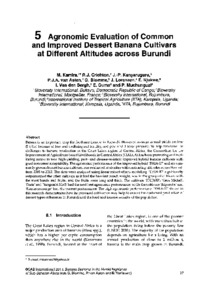| dc.contributor.author | Kamira, M. |
| dc.contributor.author | Crichton, R.J. |
| dc.contributor.author | Kanyaruguru, J.P. |
| dc.contributor.author | Asten, Piet J.A. van |
| dc.contributor.author | Blomme, Guy |
| dc.contributor.author | Lorenzen, J.H. |
| dc.contributor.author | Njukwe, E. |
| dc.contributor.author | Bergh, I. van den |
| dc.contributor.author | Ouma, Emily A. |
| dc.contributor.author | Muchunguzi, P. |
| dc.date.accessioned | 2019-12-04T11:07:51Z |
| dc.date.available | 2019-12-04T11:07:51Z |
| dc.date.issued | 2013 |
| dc.identifier.citation | Kamira, M., Crichton, R.J., Kanyaruguru, J.P., van Asten, P.J.A., Blomme, G., Lorenzen, J. ... & Muchunguzi, P. (2013). Agronomic evaluation of common and improved dessert banana cultivars at different altitudes across Burundi. In G. Blomme, P. van Asten and B. Vanlauwe, Banana systems in the humid highlands of sub-Saharan Africa: enhancing resilience and productivity (p. 37-47). Wallingford: CABI. |
| dc.identifier.isbn | 978-1-78064-231-4 |
| dc.identifier.uri | https://hdl.handle.net/20.500.12478/1618 |
| dc.description.abstract | Banana is an important crop for food and income in Burundi. However, average annual yields are low (5 t/ha) because of low and declining soil fertility, and pest and disease pressure. To help overcome the challenges to banana production in the Great Lakes region of Central Africa, the Consortium for the Improvement of Agriculture-based Livelihoods in Central Africa (CIALCA) has been promoting and facilitating access to new high-yielding, pest- and disease-resistant improved hybrid banana cultivars with good consumer acceptability. The agronomic performance of the improved hybrid 'FHIA-l7' and six commonly grown dessert banana cultivars was evaluated at six sites with contrasting altitudes across Burundi from 2008 to 2012. The data were analysed using linear mixed-effects modelling. 'FHIA-l7' significantly outperformed the other cultivars as it had the heaviest bunch weight. was in the group of cultivars with the most hands and fruits, and the fruits were long and thick. The cultivars 'ITC0680', 'Gros Michel', 'Prata' and 'Yangambi KmS' had the next best agronomic performance, while the cultivars 'Ikigurube' and 'Kamaramasenge' had the poorest performance. The high agronomic performance of 'FHlA-17' shown in this research demonstrates how its increased cultivation may help to ensure the continued production of dessert types of bananas in Burundi and the food and income security of the population. |
| dc.format.extent | 37-47 |
| dc.language.iso | en |
| dc.publisher | Centre for Agriculture and Biosciences International |
| dc.subject | Bananas |
| dc.subject | Food Security |
| dc.subject | Plant Diseases |
| dc.subject | Agronomy |
| dc.subject | Cultivars |
| dc.title | Agronomic evaluation of common and improved dessert banana cultivars at different altitudes across Burundi |
| dc.type | Book Chapter |
| dc.description.version | Peer Review |
| cg.contributor.crp | Climate Change, Agriculture and Food Security |
| cg.contributor.affiliation | Bioversity International |
| cg.contributor.affiliation | International Institute of Tropical Agriculture |
| cg.coverage.region | Africa |
| cg.coverage.region | Central Africa |
| cg.coverage.country | Burundi |
| cg.authorship.types | CGIAR multi-centre |
| cg.iitasubject | Agronomy |
| cg.iitasubject | Banana |
| cg.iitasubject | Food Security |
| cg.howpublished | Formally Published |
| cg.publicationplace | Wallingford, UK. |
| cg.accessibilitystatus | Limited Access |
| local.dspaceid | 82458 |
| cg.targetaudience | Scientists |

